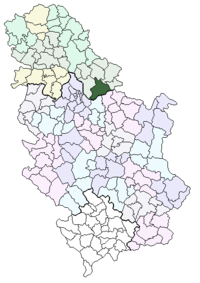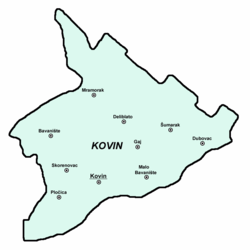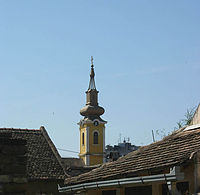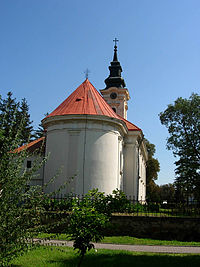- Kovin
-
Kovin
Ковин— Municipality and Town — 
Coat of armsLocation of the municipality of Kovin within Serbia Coordinates: 44°45′N 20°58′E / 44.75°N 20.967°E Country Serbia District South Banat Settlements 10 Government - Mayor Slavko Branković Area[1] - Municipality 725 km2 (279.9 sq mi) Population (2002 census)[2] - Town 14,250 - Municipality 36,802 Time zone CET (UTC+1) - Summer (DST) CEST (UTC+2) Postal code 26220, 26221, 26223 Area code +381 13 Car plates KO Website www.kovin.org.rs Kovin (Ковин) is a town and municipality in South Banat District of Vojvodina, Serbia. The town has a population of 14,250, while the municipality has 36,802 inhabitants.
Contents
Name
In Serbian, the town is known as Kovin or Ковин, in Romanian as Cuvin, in Hungarian as Kevevára or (til 1899) Temeskubin, and in German as Kubin or Temeschkubin.
In the past, the town was also known as Donji Kovin ("lower Kovin") in contrast to the town with same name in Hungary that was known in Serbian as Gornji Kovin ("upper Kovin") and in Hungarian as Ráckeve ("the Serb Kovin").
History
The Dacian tribe of Albocenses dwelled in this area in the 2nd century AD.[3]
There are remains of the ancient Roman fortress called Contra Margum, opposite to the Margum, a fortress on the other side of the Danube. In the 9th and 10th centuries, this area was populated by Slavs and Bulgarian Voivode Glad ruled over the region. Glad was defeated by the Hungarians, and the area was included into the medieval Kingdom of Hungary. In the 11th century, one of the descendants of Glad, Ahtum, ruled over the region but he, too, was defeated by the Hungarians.
Kovin is mentioned for the first time in the 12th century as a seat of the county, which included most of the western Banat. Since the 14th century, the city has had a large Serb population that escaped there from Serbia under threat by the Ottomans. The Serbian despot Lazar Branković took control over the city in 1457, but in the next year it came again under control of the Kingdom of Hungary.
In the 16th century, the city was included in the Ottoman Empire and became a part of the Ottoman Province of Temeşvar. During the Ottoman rule (16th-17th century), Kovin was mostly populated by ethnic Serbs. In 1716, it became part of the Habsburg Monarchy and belonged to the Habsburg Banat of Temeswar until 1751 when it became part of the Habsburg Military Frontier (Banat Krajina).
In 1848/1849, Kovin was part of the Serbian Voivodship, but in 1849 it was again placed under administration of the Military Frontier. With the abolishment of the Military Frontier in 1873, Kovin was incorporated into Temes county within the Habsburg Kingdom of Hungary. According to the 1910 census, Kovin District had a population of 35,482, of whom 21,795 spoke Serbian, 6,587 German, 5,705 Romanian, and 5,355 Hungarian. [2]
In 1918, Kovin became part of the Kingdom of Serbs, Croats and Slovenes (renamed to Yugoslavia in 1929). Between 1918 and 1922, it was part of Banat county; between 1922 and 1929 part of the Podunavska oblast; and between 1929 and 1941 part of the Danube Banovina. Between 1941 and 1944, Kovin was under Axis occupation and was part of the autonomous Banat region within German-occupied Serbia. The town was heavily bombed by the Allies in 1944.[4] In 1945, it became part of the Socialist Autonomous Province of Vojvodina within the Socialist Republic of Serbia and the Socialist Federal Republic of Yugoslavia. In 1992, Kovin became part of the Federal Republic of Yugoslavia, which was in 2003 transformed into the state union of Serbia and Montenegro. Since 2006, the town is part of an independent Serbia.
Inhabited places
Kovin municipality includes the town of Kovin and the following villages:
- Bavanište
- Gaj
- Deliblato
- Dubovac
- Malo Bavanište
- Mramorak
- Pločica
- Skorenovac (Hungarian: Székelykeve)
- Šumarak (Hungarian: Emánueltelep)
Historical population of the town
Year 1900 1948 1953 1961 1971 1981 1991 2002 Population 5,847 8,309 9,766 11,986 12,408 13,779 13,669 14,250 Ethnic groups
Major ethnic groups in the municipality
Year Population Serbs Germans Romanians Hungarians Croats Roma Slovaks Rest 1910 34,034 45.52% 19.30% 16.65% 15.64% 0.09% 1.28% 0.12% 1.70% 1931 35,600 50.66% 20.68% n/d 13.0% n/d n/d n/d 15.64% 1961 39,994 73.1% n/d 17.6% 13.59% n/d 0.04% 0.14% 5.27% 1991 38,263 73.53% 0.20% 4.54% 10.28% 0.39% 2.47% 0.05% 8.54% 2002 36,802 76.75% 0.13% 3.7% 9.26% 0.3% 3.1% 0.11% 7.44% Settlements by ethnic majority
Settlements with a Serb ethnic majority are: Kovin, Bavanište, Gaj, Deliblato, Dubovac, Malo Bavanište, Mramorak, and Pločica. Skorenovac has a Hungarian ethnic majority. Šumarak is an ethnically-mixed settlement with a relative Hungarian majority.
Major ethnic groups in the town
Year Total Serbs Hungarians Romanians Roma Montenegrins Yugoslavs Macedonians Rest 1991 13,669 76.19% 6.78% 3.47% 1.40% 1.67% 6.81% 0.76% 2.21% 2002 14,250 80.79% 5.51% 2.93% 2.00% 0.92% 1.26% 0.50% 6.09% Twin cities
References
- ^ "Municipalities of Serbia, 2006". Statistical Office of Serbia. http://webrzs.stat.gov.rs/axd/en/Zip/OG2006webE.zip. Retrieved 2010-11-28.
- ^ (in Serbian) Popis stanovništva, domaćinstava i Stanova 2002. Knjiga 1: Nacionalna ili etnička pripadnost po naseljima. Statistical Office of Serbia. 2003. ISBN 86-84443-00-09. May be downloaded from: [1]
- ^ Ptolemy's Geographia
- ^ Serbs were not specially chosen as targets, Danas
- Jovan Erdeljanović, Srbi u Banatu, Novi Sad, 1992.
- Slobodan Ćurčić, Broj stanovnika Vojvodine, Novi Sad, 1996.
- Msgr. Erős Lajos, Adalékok a Zrenjanini-Nagybecskereki Egyházmegye történetéhez, 1993. (Additamenta ad historiam Diocesis Zrenjaninensis-Nagybecskerekensis)
External links
- Municipality of Kovin
- Radio BUS - News from Kovin
- Kovin Ekspres - online news and newspaper from Kovin
- NETcom - Information technologies - services and data recovery
Municipalities and cities of Serbia Central Serbia Belgrade (Barajevo • Čukarica • Grocka • Lazarevac • Mladenovac • Novi Beograd • Obrenovac • Palilula • Rakovica • Savski Venac • Sopot • Stari Grad • Surčin • Voždovac • Vračar • Zemun • Zvezdara) • Čačak • Jagodina • Kragujevac (Aerodrom • Pivara • Stanovo • Stari Grad • Stragari) • Kraljevo • Kruševac • Leskovac • Loznica • Niš (Crveni Krst • Medijana • Niška Banja • Palilula • Pantelej) • Novi Pazar • Požarevac • Smederevo • Šabac • Užice • Valjevo • Vranje • Zaječar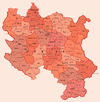 Aleksandrovac • Aleksinac • Aranđelovac • Arilje • Babušnica • Bajina Bašta • Batočina • Bela Palanka • Blace • Bogatić • Bojnik • Boljevac • Bor • Bosilegrad • Brus • Bujanovac • Crna Trava • Čajetina • Ćićevac • Ćuprija • Despotovac • Dimitrovgrad • Doljevac • Gadžin Han • Golubac • Gornji Milanovac • Ivanjica • Kladovo • Knić • Knjaževac • Koceljeva • Kosjerić • Krupanj • Kučevo • Kuršumlija • Lajkovac • Lapovo • Lebane • Lučani • Ljig • Ljubovija • Majdanpek • Mali Zvornik • Malo Crniće • Medveđa • Merošina • Mionica • Negotin • Nova Varoš • Osečina • Paraćin • Petrovac • Pirot • Požega • Preševo • Priboj • Prijepolje • Prokuplje • Rača • Raška • Ražanj • Rekovac • Sjenica • Smederevska Palanka • Sokobanja • Surdulica • Svilajnac • Svrljig • Topola • Trgovište • Trstenik • Tutin • Ub • Varvarin • Velika Plana • Veliko Gradište • Vladičin Han • Vladimirci • Vlasotince • Vrnjačka Banja • Žabari • Žagubica • Žitorađa
Aleksandrovac • Aleksinac • Aranđelovac • Arilje • Babušnica • Bajina Bašta • Batočina • Bela Palanka • Blace • Bogatić • Bojnik • Boljevac • Bor • Bosilegrad • Brus • Bujanovac • Crna Trava • Čajetina • Ćićevac • Ćuprija • Despotovac • Dimitrovgrad • Doljevac • Gadžin Han • Golubac • Gornji Milanovac • Ivanjica • Kladovo • Knić • Knjaževac • Koceljeva • Kosjerić • Krupanj • Kučevo • Kuršumlija • Lajkovac • Lapovo • Lebane • Lučani • Ljig • Ljubovija • Majdanpek • Mali Zvornik • Malo Crniće • Medveđa • Merošina • Mionica • Negotin • Nova Varoš • Osečina • Paraćin • Petrovac • Pirot • Požega • Preševo • Priboj • Prijepolje • Prokuplje • Rača • Raška • Ražanj • Rekovac • Sjenica • Smederevska Palanka • Sokobanja • Surdulica • Svilajnac • Svrljig • Topola • Trgovište • Trstenik • Tutin • Ub • Varvarin • Velika Plana • Veliko Gradište • Vladičin Han • Vladimirci • Vlasotince • Vrnjačka Banja • Žabari • Žagubica • ŽitorađaVojvodina  Ada • Alibunar • Apatin • Bač • Bačka Palanka • Bačka Topola • Bački Petrovac • Bečej • Bela Crkva • Beočin • Čoka • Inđija • Irig • Kanjiža • Kikinda • Kovačica • Kovin • Kula • Mali Iđoš • Nova Crnja • Novi Bečej • Novi Kneževac • Odžaci • Opovo • Pećinci • Plandište • Ruma • Sečanj • Senta • Šid • Srbobran • Sremski Karlovci • Stara Pazova • Temerin • Titel • Vrbas • Vršac • Žabalj • Žitište
Ada • Alibunar • Apatin • Bač • Bačka Palanka • Bačka Topola • Bački Petrovac • Bečej • Bela Crkva • Beočin • Čoka • Inđija • Irig • Kanjiža • Kikinda • Kovačica • Kovin • Kula • Mali Iđoš • Nova Crnja • Novi Bečej • Novi Kneževac • Odžaci • Opovo • Pećinci • Plandište • Ruma • Sečanj • Senta • Šid • Srbobran • Sremski Karlovci • Stara Pazova • Temerin • Titel • Vrbas • Vršac • Žabalj • ŽitišteKosovo Dečani • Đakovica • Dragaš • Glogovac • Gnjilane • Istok • Kačanik • Klina • Kosovo Polje • Kosovska Kamenica • Kosovska Mitrovica • Leposavić • Lipljan • Mališevo • Novo Brdo • Obilić • Orahovac • Peć • Podujevo • Priština • Prizren • Štimlje • Srbica • Štrpce • Suva Reka • Uroševac • Vitina • Vučitrn • Zubin Potok • Zvečan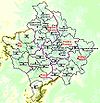 New Municipalities: Đeneral Janković • Gračanica • Junik • Klokot-Vrbovac • Mamuša • Parteš • RanilugCategories:
New Municipalities: Đeneral Janković • Gračanica • Junik • Klokot-Vrbovac • Mamuša • Parteš • RanilugCategories:- Populated places in Vojvodina
- Municipalities of Vojvodina
- Places in Serbian Banat
Wikimedia Foundation. 2010.

